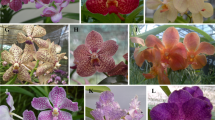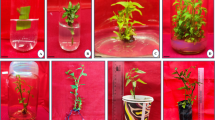Abstract
The regeneration ability of primary explants derived from mericlones of two commercial Bohemian hops was investigated. It was found that these hops are able to regenerate shoots by direct organogenesis on media containing BAP or zeatin at concentrations 0.5–2 mg dm−3. The highest regeneration of shoots was achieved from either petioles or internodes at frequencies 21% and 52%, respectively, on the medium containing zeatin (2 mg dm−3), while relatively low amount of regenerated shoots (1.3%) was observed for leaf blade explants. On the other hand, more efficient rooting occurred on the leaf blades then on other explants. A similar pattern of regeneration we observed for HLVd-infected mericlones of clone Osvald 31 even though viroid concentration inin vitro cultures was about 8-fold higher than in field-grown plants and was 31.1 pg mg−1 of fresh mass in the average. These results suggest that HLVd infection did not impair organogenesis. We found that high 2,4-D concentration pretreatment (11 mg dm−3) did not promote somatic embryogenesis. Although this treatment suppressed direct organogenesis, the inhibition was not complete and in low frequency the shoot regeneration was seen. Sensitivity of hop explants to antibiotics commonly used inAgrobacterium-mediated transformation was assayed. It was found that kanamycin (100–200 mg dm−3) suppressed efficiently callogenesis, root formation and shoot proliferation. An estimation of effect of kanamycin (200 mg dm−3) and ticarcillin (500 mg dm−3) on morphogenesis was performed using regeneration medium. The inhibitory effects observed suggest that these conditions could be used inAgrobacterium transformation/selection system.
Similar content being viewed by others
Abbreviations
- 2,4-D:
-
2,4-dichlorophenoxyacetic acid
- BAP:
-
6-benzylaminopurine
- ZEA (transzeatin):
-
6-[4-hydroxy-3-methyl-but-2-enylamino]purine
- AMESS:
-
0.5 M sodium acetate buffer (pH 6.0) containing 10 mM MgCl2, 20% ethanol, 3% SDS, and 1 M NaCl
- HLVd:
-
hop latent viroid
- HSVd:
-
hop stunt viroid
References
Adams, A.N.: Elimination of viruses of the hop (Humulus lupulus) by heat therapy and meristem culture.—J. hort. Sci.58: 151–160, 1975.
Adams, A.N., Barbara, D.J., Morton, A.: Effects of hop latent viroid on weight and quality of the cones of the hop cultivar Wye Challenger.—Ann. appl. Biol.118 (Suppl.): 126–127, 1991.
Ammirato, P.V.: Embryogenesis.—In: Evans, D.A., Sharp, W.R., Ammirato, P.V., Yamada, Y. (ed.): Handbook of Plant Cell Culture. Vol. 1. Techniques for Propagation and Breeding. Pp. 82–123. MacMillan Publishing Company, New York 1983.
Barbara, D.J., Morton, A., Adams, A.N.: Assessment of UK hops for the occurrence of hop latent and hop stunt viroids.—Ann. appl. Biol.116: 265–272, 1990.
Connell, S.A., Heale, J.B.: Development of anin vitro selection system for novel sources of resistance toVerticillium wilt in hops.—In: Withers, L.A., Alderson, P.G. (ed.): Plant Tissue Culture and its Agricultural Applications. Pp. 451–459. Butterworth Publishers, Stoneham 1986.
D'Amato, F.: Chromosome number variation in cultured cells and regenerated plants.—In: Thorpe, T.A. (ed.): Frontiers of Plant Tissue Culture. Pp. 287–295. University of Calgary, Galgary 1978.
Evans, D.A., Sharp, W.R.: Somaclonal and gametoclonal variation.—In: Evans, D.A., Sharp, W.R., Ammirato, P.V. (ed.): Handbook of Plant Cell Culture. Vol 4: Techniques and Applications. Pp. 97–132. MacMillan Publishing Company, New York 1986.
Furze, J.M., Rhodes, M.J.C., Robins, R.J.: The use of agarose bead culture for the regeneration of single cell-derived colonies from protoplasts isolated from suspension cultures ofHumulus lupulus.—Plant Cell Tissue Organ Cult.8: 17–25, 1987.
Heale, J.B., Legg, T., Connell, S.:Humulus lupulus L. (Hop):In vitro culture; attempted production of bittering components and novel disease resistance—In: Bajaj, Y.P.S. (ed.): Biotechnology in Agriculture and Forestry. Vol. 7. Medicinal and Aromatic Plants II. Pp.264–285. Springer-Verlag, Berlin-Heidelberg-New York 1989.
Horsch, R.B., Fry, J.E., Hoffmann, N.L., Eichholtz, D., Rogers, S.G., Fraley, R.T.: A simple and general method for transferring genes into plants.—Science227: 1129–1231, 1985.
Langezaal, C.R., Scheffer, J.J.C.: Initiation and growth characterization of some hop cell suspension cultures.—Plant Cell Tissue Organ Cult.30: 159–164, 1992.
McDonnell, R.E., Clarck, R.D., Smith, W.A., Hinchee, M.A.: A simplified method for the detection of neomycin phosphotranferase II activity in transformed plant tissues.—Plant mol. Biol. Rep.5: 380–386, 1987.
MacQuaire, G., Monsion, M., Mouches, C., Candresse, T., Dunez, J.: Spot hybridization. Application to viroid identification.—Ann. Virol.135: 219–230, 1984.
Matoušek, J., Rakouský, S.: Antisense DNA inhibits infection of potato spindle tuber viroids.—Folia biol. (Praha)39: 87–99, 1993.
Motegi, T.: [Induction of redifferentiated plant from hop leaf callus cultures.]—Proc. Crop Sci. Soc. Jap.45: 175–176, 1976. [In Jap.]
Murashige, T., Skoog, F.: A revised medium for rapid growth and bioassay with tobacco tissue cultures.—Physiol. Plant.14: 473–497, 1962.
Ohno, T., Takamatsu, N., Meshi, T., Okada, Y.: Hop stunt viroid: molecular cloning and nucleotide sequence of the complete cDNA copy.—Nucleic Acids Res.11: 6185–6197, 1983.
Paar, J., Adrian, J., Smith, R.J., Robins-Rhodes, J.C.: Apparent free space and cell volume estimation: A non-destructive method for assessing the growth membrane integrity (viability of immobilised plant cells).—Plant Cell Rep.3: 161–164, 1984.
Palukaitis, P., Cotts, S., Zaitlin, M.: Detection and identification of viroids and viral nucleic acids by “dot-blot” hybridization.—Acta Hort.164: 109–117, 1985.
Popov, V.I., Vysotskii, V.A., Toktagulov, I.M.: [Conditions of cultivation of isolated hop apices for clonal micropropagation.]—Fiziol. Rast.32: 1191–1195, 1985. [In Russ.]
Puchta, H., Ramm, K., Sänger, H.L.: The molecular structure of hop latent viroid (HLVd), a new viroid occurring worldwide in hops.—Nucleic Acids Res.16: 4197–4216, 1988.
Puchta, H., Ramm, K., Sänger, H.L.: Hop latent viroid (HLVd) and the worldwide distribution of latent viroids in vegetatively propagated plants.—In: Eppler A. (ed.): Proceedings of Internal Workshop on Hop Virus Diseases. Pp. 181–190. Deutsche Phytomedizinische Gesellschaft, Rauischholzhausen 1989.
Robins, R.J., Furze, J.M., Rhodes, M.J.C.: D-acid degradation by suspension culture cells ofHumulus lupulus.—Phytochemistry24: 709–714, 1985.
Sano, T., Oshima, K., Hataya, T., Uyeda, I., Shikata, E., Chou, T.-G., Meshi, T., Okada, Y.: A viroid resembling hop stunt viroid in grapevines from Europe, the United States and Japan.— J. gen. Virol.67: 1673–1678, 1986.
Samyn, G., Welvaert, W.: Producing a “nuclear stock” of virusfree hop plants.—Med. Fac. Landbouww. Rijksuniv. Gent48: 877–881, 1983.
Svoboda, P.: [Hormonal regulation of growth of isolated shoot tip meristems of hop (Humulus lupulus L.) inin vitro culture.]—Rost. Výroba (Praha)34: 713–716, 1988. [In Czech]
Svoboda, P.: [Clonal propagation of hopin vitro.]—Rost. Výroba (Praha)37: 643–648, 1991. [In Czech]
Svoboda, P.: [Hop explantate cultures.]—Rost. Výroba (Praha)38: 107–112, 1992. [In Czech]
Takahashi, T., Fujiwara, S., Chiba, K., Yoshikawa, N.: Comparison of plant hormone requirements in leaf tissues from hop stunt viroid-infected and uninfected hop plants.—Z. Pflanzenkrank. Pflanzenschutz99: 62–70, 1992.
Tisserat, B.: Embryogenesis, organogenesis and plant regeneration.—In: Dixon, R.A. (ed.): Plant Cell Culture. A Practical Approach. Pp. 79–106. IRL Press, Oxford-Washington 1985.
Vine, S.J., Jones, O.P.: The culture of shoot tips of hop (Humulus lupulus L.) to eliminate viruses.— J. hort. Sci.44: 181–284, 1969.
Author information
Authors and Affiliations
Additional information
Communicated by J. TUPÝ
Rights and permissions
About this article
Cite this article
Rakouský, S., Matoušek, J. Direct organogenesis in hop - a prerequisite for an application ofA. tumefaciens-mediated transformation. Biol Plant 36, 191–200 (1994). https://doi.org/10.1007/BF02921085
Received:
Accepted:
Issue Date:
DOI: https://doi.org/10.1007/BF02921085




